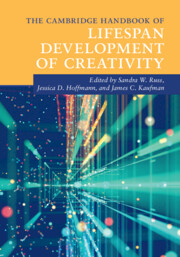Book contents
- The Cambridge Handbook of Lifespan Development of Creativity
- The Cambridge Handbook of Lifespan Development of Creativity
- Copyright page
- Dedication
- Contents
- Figures
- Tables
- Contributors
- Acknowledgments
- Introduction
- Part I Core Concepts of Lifespan Creativity Development
- 1 Basic Concepts of Creativity
- 2 The Creative Brain
- 3 Pretend Play
- 4 Creativity across the Lifespan
- Part II The Development of Creativity
- Part III Modes of Enhancement
- Part IV Environments and Contexts
- Part V Special Populations
- Index
- References
4 - Creativity across the Lifespan
from Part I - Core Concepts of Lifespan Creativity Development
Published online by Cambridge University Press: 19 November 2021
- The Cambridge Handbook of Lifespan Development of Creativity
- The Cambridge Handbook of Lifespan Development of Creativity
- Copyright page
- Dedication
- Contents
- Figures
- Tables
- Contributors
- Acknowledgments
- Introduction
- Part I Core Concepts of Lifespan Creativity Development
- 1 Basic Concepts of Creativity
- 2 The Creative Brain
- 3 Pretend Play
- 4 Creativity across the Lifespan
- Part II The Development of Creativity
- Part III Modes of Enhancement
- Part IV Environments and Contexts
- Part V Special Populations
- Index
- References
Summary
This chapter on “Creativity across the Lifespan” proceeds to address several overarching issues in creativity from a lifespan developmental perspective, making contact with the developmental, creativity, and development of creativity literatures. It makes no claims to be exhaustive as each of these literatures is now extensive. The chapter proceeds, in the first part, to overview definitions and history, stages, and principles of lifespan developmental science, including general developmental approaches, designs, consistency and change, and domains, as well as theories. The second part of the chapter reviews work in creativity from a lifespan developmental perspective, evaluating conceptual definitions; measurement in adults, children, and infants; and psychological associations of creativity with attention, cognition, language, and intelligence as well as personality and emotions. The third part of the chapter takes up the main moderators of creativity across the lifespan, viz. age, domain, gender, sources in nature and nurture, and culture. Before concluding, the fourth part of the chapter forecasts future directions in a lifespan development approach to creativity, asking if creativity can be promoted and looking toward new work in interdisciplinarity and neuroscience. Understanding creativity is inherently an interdisciplinary effort as is the study of the lifespan. Disciplines from anthropology to zoology have much to say about both; in all, however, this chapter adopts a psychological orientation to treating creativity across the lifespan.
- Type
- Chapter
- Information
- Publisher: Cambridge University PressPrint publication year: 2021
References
- 1
- Cited by



